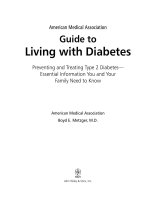GUIDE TO INFECTIOUS DISEASES FOR SCHOOLS AND DAY CARE CENTERS docx
Bạn đang xem bản rút gọn của tài liệu. Xem và tải ngay bản đầy đủ của tài liệu tại đây (127.65 KB, 14 trang )
TABLE OF CONTENTS
GUIDE TO
INFECTIOUS DISEASES
FOR SCHOOLS AND
DAY CARE CENTERS
CHICKENPOX . . . . . . . . . . . . . . . . . . . . . . . . . . . . . . . . . . . . . . . . . . . . . . . . . . . . . . 1
COMMON COLD . . . . . . . . . . . . . . . . . . . . . . . . . . . . . . . . . . . . . . . . . . . . . . . . . 1-2
CONJUNCTIVITIS . . . . . . . . . . . . . . . . . . . . . . . . . . . . . . . . . . . . . . . . . . . . . . . . . . . 2
CROUP . . . . . . . . . . . . . . . . . . . . . . . . . . . . . . . . . . . . . . . . . . . . . . . . . . . . . . . . . . . 3
DIARRHEAL DISEASES
CAMPYLOBACTERIOSIS . . . . . . . . . . . . . . . . . . . . . . . . . . . . . . . . . . . 3-4
GIARDIASIS . . . . . . . . . . . . . . . . . . . . . . . . . . . . . . . . . . . . . . . . . . . . . . . . 4
SALMONELLOSIS . . . . . . . . . . . . . . . . . . . . . . . . . . . . . . . . . . . . . . . . . . . 5
SHIGELLOSIS . . . . . . . . . . . . . . . . . . . . . . . . . . . . . . . . . . . . . . . . . . . . 5-6
YERSINIOSIS . . . . . . . . . . . . . . . . . . . . . . . . . . . . . . . . . . . . . . . . . . . . . . . 6
FIFTH DISEASE . . . . . . . . . . . . . . . . . . . . . . . . . . . . . . . . . . . . . . . . . . . . . . . . . . . . 7
FLU . . . . . . . . . . . . . . . . . . . . . . . . . . . . . . . . . . . . . . . . . . . . . . . . . . . . . . . . . . . . 7-8
GERMAN MEASLES . . . . . . . . . . . . . . . . . . . . . . . . . . . . . . . . . . . . . . . . . . . . . . 8-9
HAND, FOOT AND MOUTH DISEASE . . . . . . . . . . . . . . . . . . . . . . . . . . . . . . . . . . 9
HEAD AND BODY LICE . . . . . . . . . . . . . . . . . . . . . . . . . . . . . . . . . . . . . . . . . . . 9-10
HEPATITIS A . . . . . . . . . . . . . . . . . . . . . . . . . . . . . . . . . . . . . . . . . . . . . . . . . . . 10-11
HEPATITIS B . . . . . . . . . . . . . . . . . . . . . . . . . . . . . . . . . . . . . . . . . . . . . . . . . . . 11-12
IMPETIGO . . . . . . . . . . . . . . . . . . . . . . . . . . . . . . . . . . . . . . . . . . . . . . . . . . . . . . . . 12
MEASLES . . . . . . . . . . . . . . . . . . . . . . . . . . . . . . . . . . . . . . . . . . . . . . . . . . . . . 12-13
MENINGITIS (BACTERIAL) . . . . . . . . . . . . . . . . . . . . . . . . . . . . . . . . . . . . . . . 13-14
MENINGITIS (ASEPTIC-VIRAL) . . . . . . . . . . . . . . . . . . . . . . . . . . . . . . . . . . . . . . . 14
MONONUCLEOSIS . . . . . . . . . . . . . . . . . . . . . . . . . . . . . . . . . . . . . . . . . . . . . . . . 15
MUMPS . . . . . . . . . . . . . . . . . . . . . . . . . . . . . . . . . . . . . . . . . . . . . . . . . . . . . . 15-16
RINGWORM . . . . . . . . . . . . . . . . . . . . . . . . . . . . . . . . . . . . . . . . . . . . . . . . . . . . . . 16
SCABIES . . . . . . . . . . . . . . . . . . . . . . . . . . . . . . . . . . . . . . . . . . . . . . . . . . . . . . . . . 17
SCARLET FEVER . . . . . . . . . . . . . . . . . . . . . . . . . . . . . . . . . . . . . . . . . . . . . . . 17-18
THRUSH . . . . . . . . . . . . . . . . . . . . . . . . . . . . . . . . . . . . . . . . . . . . . . . . . . . . . . . . . 18
Allegheny County Health Department
Divisions of Infectious Diseases
Phone (412) 578-8060
TUBERCULOSIS . . . . . . . . . . . . . . . . . . . . . . . . . . . . . . . . . . . . . . . . . . . . . . . . . . . 19
WHOOPING COUGH (PERTUSSIS) . . . . . . . . . . . . . . . . . . . . . . . . . . . . . . . . 19-20
WORMS . . . . . . . . . . . . . . . . . . . . . . . . . . . . . . . . . . . . . . . . . . . . . . . . . . . . . . 20-21
SEXUALLY TRANSMITTED DISEASES
GONORRHEA . . . . . . . . . . . . . . . . . . . . . . . . . . . . . . . . . . . . . . . . . . 21-22
CHLAMYDIA . . . . . . . . . . . . . . . . . . . . . . . . . . . . . . . . . . . . . . . . . . . 22-23
SYPHILIS . . . . . . . . . . . . . . . . . . . . . . . . . . . . . . . . . . . . . . . . . . . . . . 23-24
CLOSE
ANIMAL BITES . . . . . . . . . . . . . . . . . . . . . . . . . . . . . . . . . . . . . . . . . . . . . . . . . 24-25
CHICKENPOX
(Varicella)
INCUBATION AND SYMPTOMS
METHODS OF SPREAD
Direct contact with an infected person, or indirectly by contact with articles
freshly soiled by discharge from nose and throat of the infected person.
MINIMUM CONTROL MEASURES
Infectious Agent: Varicella - Zoster Virus (herpesvirus 3)
Incubation: 2-3 weeks, usually 13-17 days; may be prolonged after
passive immunization against varicella and in the immunodeficient.
Symptoms: Sudden onset of slight fever, skin rash consisting of small
blisters which leave scabs. Eruptions occur in crops. Pimples, blisters and
scabs may all be present at the same time.
Period of Communicability: Usually 24 hours before onset of symptoms
and until 5 days after onset.
Control: Exclude from school/center until child is able to resume normal
activities.
CONJUNCTIVITIS
METHODS OF SPREAD
Direct contact with or droplet/airborne spread of respiratory secretions of
an infected person.
(Pink Eye)
INCUBATION AND SYMPTOMS
MINIMUM CONTROL MEASURES
Period of Communicability: As long as 4 days, but usually 1-2 days
before onset of rash/blisters, and until all vesicles are dry.
Infectious Agents: Haemophilus influenzae, Streptococcus
pneumoniae, et al
Incubation: Usually 24-72 hours.
Control: Exclude from school/center for 6 days from the last crop of
vesicles, or until vesicles become dry.
Concurrent Disinfection: Disinfect articles soiled by discharge from the
nose and throat, and from lesions.
OTHER INFORMATION
Children with leukemia or otherwise immunocompromised are at increased
risk for complications.
Symptoms: Eyes are red, watery, itchy and sensitive to light; eyelids are
frequently swollen.
METHODS OF SPREAD
Direct contact with eye and upper respiratory tract discharges of infected
persons, or indirectly by contact with contaminated articles of person
infected, including eye makeup applicators and multiple dose eye
medication droppers.
MINIMUM CONTROL MEASURES
COMMON COLD
INCUBATION AND SYMPTOMS
Incubation: 12-72 hours, usually 48 hours.
Period of Communicability: Duration of active infection.
Control: Exclude from school/center until 24 hours after start of
appropriate treatment, or until physician certifies as non-infectious.
Symptoms: Irritated throat, watery discharge from nose and eyes,
sneezing, chills and general body discomfort.
-1-
-2-
CROUP
INCUBATION & SYMPTOMS
Incubation: Variable, depending upon causative agent.
Symptoms: Acute respiratory infection which involves the larynx, trachea
and bronchi, and causes severe respiratory distress.
METHODS OF SPREAD
Direct contact with an infected person, or indirectly by contact with articles
freshly soiled by discharge from nose and throat of the infected person.
MINIMUM CONTROL MEASURES
Period of Communicability: Duration of active disease.
Control: Exclude from school/center until symptoms are gone or
physician authorizes return.
METHOD OF SPREAD
By ingestion of the organism in food or in unpasteurized milk or water;
from contact with infected pets (especially puppies and kittens) or farm
animals. Person-to-person transmission has been reported in day care
when children are in diapers (i.e., incontinent of stool).
MINIMUM CONTROL MEASURES
Period of Communicability: Throughout the course of infection, usually
from several days to several weeks. Individuals not treated with antibiotics
excrete the organism for as long as 2-7 weeks.
Control: Children attending or employees associated with day care, preschool, Headstart or nurseries may not attend the center if they are
symptomatic. To minimize the risk of transmission, emphasize thorough
handwashing by children and staff before eating and after toilet use and
diaper changes. Persons handling and preparing food should give
particular attention to handwashing.
OTHER INFORMATION
GIARDIASIS
Medical attention may be necessary.
DIARRHEAL DISEASES
This Section has been prepared for the most common diarrheal diseases. If your
school/center is experiencing an outbreak of diarrhea, please contact the Health
Department while waiting for a confirmation of a specific disease.
NOTE: The Health Department is to be notified immediately of any person in
the school/center diagnosed with any of the following diseases:
PROPER HANDWASHING IS THE MOST EFFECTIVE MEANS OF PREVENTING
THE SPREAD OF DIARRHEAL DISEASES.
CAMPYLOBACTERIOSIS
INCUBATION & SYMPTOMS
INCUBATION & SYMPTOMS
Infectious Agent: Giardia lamblia
Incubation: 5-25 days or longer; median 7-10 days.
Symptoms: It is common not to have symptoms. However, symptoms
may include chronic diarrhea, abdominal cramps, bloating, frequent loose,
pale and greasy stools, fatigue and weight loss.
METHOD OF SPREAD
Person-to-person transmission occurs via the fecal/oral route. May also be
spread by ingestion of water or food contaminated with feces.
MINIMUM CONTROL MEASURES
Period of Communicability: Entire period of infection.
Infectious Agents: Campylobacter jejuni, et al
Incubation: Usually 3-5 days, with a range of 1-10 days.
Symptoms: Diarrhea, abdominal pain, fever, nausea, vomiting, and a
general feeling of sickness.
-3-
Control: Children or employees associated with day care, pre-school,
Headstart, or nurseries may not attend the center if they are symptomatic.
To minimize the risk of transmission, emphasize thorough handwashing
by children and staff before eating and after toilet use and diaper changes.
Persons handling and preparing food should give particular attention
to handwashing.
-4-
SALMONELLOSIS
INCUBATION & SYMPTOMS
Infectious Agent: Salmonella enteritidis, S. typhimurium, et. al
Incubation: 6-72 hours, usually 12-36 hours.
Symptoms: Sudden onset of headache, abdominal pain, diarrhea, nausea,
and sometimes vomiting. Dehydration, especially among infants, may be
severe. Fever is almost always present.
METHODS OF SPREAD
Exposure to feces of infected animals, including household pets; ingestion
of contaminated food or water, undercooked foods, or improperly stored
foods. Likelihood of transmission from person to person is greatest when
diarrhea is present. This occurs chiefly in very young children (i.e., less
than 1 year).
METHOD OF SPREAD
Person-to-person contact either by direct or indirect transmission.
Individuals most responsible for the spread of disease are those who fail to
thoroughly wash hands and under fingernails after bathroom use. They
may then spread infection to others directly by physical contact or
indirectly by contaminating food. Flies may transfer the organism onto a
non-refrigerated or improperly covered food item.
MINIMUM CONTROL MEASURES
Period of Communicability: Entire period of infection. Individuals
without symptoms may transmit the disease.
Control: Children or employees associated with day care, pre-school,
Headstart or nurseries may not attend the center until they have been
cleared by the Health Department. To minimize the risk of spread,
emphasize thorough handwashing by children and staff before eating and
after toilet use and diaper changes. Persons handling and preparing
food should give particular attention to handwashing.
MINIMUM CONTROL MEASURES
Period of Communicability: Throughout the course of infection;
extremely variable, usually several days to several weeks. (Temporary
carrier state occasionally continues for months, especially in infants.)
Control: Children or employees associated with day care, pre-school,
Headstart or nurseries may not attend the center if they are symptomatic.
To minimize the risk of spread, emphasize thorough handwashing by
children and staff before eating and after toilet use and diaper changes.
Persons handling and preparing food should give particular attention
to handwashing.
SHIGELLOSIS
INCUBATION & SYMPTOMS
Infectious Agent: genus Shigella
Incubation: 12-96 hours (usually 1-3 days), and up to one week for S.
dysenteriae 1.
Symptoms: Characterized by diarrhea, fever and nausea, sometimes
vomiting and cramps.
YERSINIOSIS
INCUBATION & SYMPTOMS
Infectious Agent: genus Yersinia
Incubation: Usually 3-7 days, generally under 10 days.
Symptoms: Acute, watery diarrhea (especially in young children), fever,
headache, pharyngitis, anorexia, vomiting.
Method of Spread: Eating and drinking food and/or water that has been
contaminated with feces, or by contact with infected persons or animals.
MINIMUM CONTROL MEASURES
Period of Communicability: At least as long as symptoms are present,
usually 2-3 weeks. Untreated cases may excrete the organism for 2-3
months.
Control: Children or employees associated with day care, pre-school,
Headstart or nurseries may not attend the center if they are symptomatic.
To minimize the risk of spread, emphasize thorough handwashing by
children and staff before eating and after toilet use and diaper changes.
Persons handling and preparing food should give particular attention
to handwashing.
END OF DIARRHEAL DISEASES
-5-
-6-
FIFTH DISEASE
(Erythema Infectiosum)
INCUBATION & SYMPTOMS
Infectious Agent: Parvovirus B19
Incubation: Variable; from 4-20 days until development of rash.
Symptoms: Characteristic is a striking erythema of the cheeks (slappedface appearance), followed in 1-4 days by a lace-like rash on trunk and
extremities which fades but may reappear. Differentiation from rubella and
scarlet fever is often necessary.
METHODS OF SPREAD
METHODS OF SPREAD
Direct contact with an infected person through droplet spread of nose and
throat secretions; primarily spread among crowded populations in
enclosed spaces. Rarely, influenza may be transmitted by air-borne
particles.
MINIMUM CONTROL MEASURES
Period of Communicability: Probably 3-5 days from clinical onset in
adults; up to 7 days in young children.
Control: Exclude from school/center until symptoms are gone.
OTHER INFORMATION
Routine immunization is NOT recommended for children.
Contact with infected respiratory secretions.
GERMAN MEASLES
MINIMUM CONTROL MEASURES
Period of Communicability: Greatest before onset of rash, probably not
communicable after onset of rash.
(Rubella)
INCUBATION & SYMPTOMS
Control: Children with Fifth Disease do NOT need to be excluded from
school since they are not contagious once the rash occurs.
Concurrent Disinfection: Routine handwashing and proper disposal of
tissues used while sneezing, coughing and nose blowing are indicated to
reduce the spread of Fifth Disease.
FLU
(Influenza)
INCUBATION & SYMPTOMS
Infectious Agents: Influenza virus types A, B and C
Infectious Agent: genus Rubivirus
Incubation: 16-18 days, with a range of 14-23 days.
Symptoms: Skin rash and mild fever. Glands at back of head behind ear
and along back of neck are often enlarged. Up to half the infections occur
without evident rash.
METHODS OF SPREAD
Infection is by droplet spread, contact with nasopharyngeal secretions, or
direct contact with infected person.
MINIMUM CONTROL MEASURES
Incubation: Short, usually 1-5 days.
Period of Communicability: Highly communicable from a few days
before to at least 4 days after the onset of rash.
Symptoms: Abrupt onset of fever, chills, headache and sore muscles.
Runny nose, sore throat and cough are common. Nausea, vomiting and/or
diarrhea may occur, particularly in children.
Control: Exclude from school/center for at least 4 days after the onset of
rash.
-7-
-8-
OTHER INFORMATION
Suspected cases should be reported by phone to the Health Department.
Immunization of all children attending school is required by law. While
mild in children, the disease when contracted by a pregnant woman
may cause serious consequences to the unborn child.
HAND, FOOT AND MOUTH DISEASE
(HFMD)
Symptoms: Irritation and itching of scalp or body; presence of small light
grey insects and/or their eggs (nits) which are attached to the base of the
hairs.
METHODS OF SPREAD
Direct contact with an infected person and indirect contact with their
personal belongings, especially clothing and headgear.
MINIMUM CONTROL MEASURES
INCUBATION & SYMPTOMS
Infectious Agent:
primarily, coxsackievirus A-16 (CA16); also,
enterovirus 71 (EV71)
Incubation:
Usually 3-7 days
Symptoms:
Generally, mild fever, malaise, mouth ulcers and a
rash, often blisters, located on palms, soles and
buttocks. Fever begins first, then 1-2 days later
mouth ulcers and rash appear.
Period of Communicability: While lice or nits remain alive on the infested
person or in clothing.
Control: Exclude from school/center until adequately treated and until
judged noninfectious by the child's physician or by the school/center nurse.
OTHER INFORMATION
When a student is found with head lice, all family members should be
inspected and treated. All students in infested classrooms should be
inspected and those infested should be excluded.
METHODS OF SPREAD
HEPATITIS A
Direct person to person contact with nose and throat secretions and feces
of infected people.
MINIMUM CONTROL MEASURES
(HAV)
INCUBATION & SYMPTOMS
Period of Communicability: At the time of acute illness phase. The
viruses may persist in feces for several weeks.
Control: Enteric precautions should be observed and good personal
hygiene, including thorough handwashing practiced.
Disinfect
contaminated surfaces and wash soiled clothing. Exclude from school if ill.
HEAD AND BODY LICE
(Pediculosis capitas)
(Pediculosis corpora)
INCUBATION & SYMPTOMS
Infectious Agent: hepatitis A virus
Incubation: 15-50 days, average 28-30 days.
Symptoms: Usually abrupt onset with loss of appetite, fever, abdominal
pain, nausea and fatigue. Jaundice may follow in a few days.
METHODS OF SPREAD
Person to person contact by fecal/oral route:
contaminated water and food.
ingestion of feces-
MINIMUM CONTROL MEASURES
Infectious Agents: Pediculosis capitis, P. humanus
Incubation: The eggs of lice may hatch in one week and sexual maturity
is reached approximately 8-10 days after hatching.
-9-
Period of Communicability: Most highly communicable during the last
half of incubation period and continuing for a few days after onset of
jaundice. Most cases are probably noninfectious after the 1st week of
jaundice.
-10-
Control: For proven hepatitis A, enteric precautions should be observed:
emphasize thorough handwashing for children and staff before eating and
after toilet use and diaper changes. Exclusion from school/center is
decided on a case by case basis. Food handlers with known or
suspected hepatitis A may not work with food until a physician clears
the person for work.
OTHER INFORMATION
Control: Educate about transmission methods. Infected persons should
be under a physician's care.
IMPETIGO
INCUBATION & SYMPTOMS
Infectious Agent: Staphylococcus aureus; Group A Streptococcus
Consult the Health Department for assistance and guidance in controlling
the disease within the school/center.
HEPATITIS B
Incubation: Staphylococcus aureus: commonly 4-10 days, can be
variable and indefinite.
Streptococcus: 1-3 days
Symptoms: Blister-like lesions which later develop into pustules of
irregular shape.
(HBV)
METHODS OF SPREAD
INCUBATION & SYMPTOMS
Infectious Agent: hepatitis B virus
Incubation: 45-180 days, average 60-90 days.
Symptoms: Onset is gradual, with loss of appetite, vague abdominal
discomfort, nausea, vomiting, joint aches and rash. May progress to
jaundice. Fever may be mild or absent. Some infected persons may be
asymptomatic.
Direct contact with draining sores or soiled bandages. Stress good
personal hygiene, emphasizing thorough handwashing.
MINIMUM CONTROL MEASURES
Period of Communicability: From onset of symptoms until sores are
healed.
Control: Exclude from school/center until sores are no longer draining and
the child is judged noninfectious by the nurse or the child's physician.
METHODS OF SPREAD
OTHER INFORMATION
The virus is found in almost all body secretions; however, only blood and
blood products, saliva, semen, and vaginal fluids have been shown to be
infectious. Transmission occurs through contaminated needles, (i.e. IV, IM,
subcutaneous or intradermal use, including accidental needle sticks);
sexual exposure (either homosexual or heterosexual); perinatally; and
occasionally by sharing razors or toothbrushes with an infected person.
Early detection and adequate treatment are important in preventing spread.
Infected individuals should use separate towels and wash cloths; sores
should be bandaged and dressings should be disposed of as any infectious
material.
MEASLES
Fecal/oral transmission has not been demonstrated.
MINIMUM CONTROL MEASURES
(Rubeola)
Period of Communicability: Highly communicable many weeks before
the onset of first symptoms and remains infectious through the acute
clinical course of the disease. A person who is a chronic carrier may
remain infectious for life.
INCUBATION & SYMPTOMS
Infectious Agent: Measles virus
Incubation: 7-18 days, usually 10 days.
-11-
-12-
Symptoms: Acute, highly communicable disease with fever, cough, runny
eyes and nose, followed by a dark red elevated rash that occurs in patches.
MINIMUM CONTROL MEASURES
Period of Communicability: Up to 24 hours after initiation of antibiotic
therapy. Penicillin does not eradicate organisms from nasopharynx.
METHODS OF SPREAD
Direct contact with secretions of nose and throat of infected persons;
indirectly airborne and by articles freshly soiled with secretions of nose and
throat.
Control: Exclude from school/center until adequately treated. Student
must be under a physician's care.
OTHER INFORMATION
MINIMUM CONTROL MEASURES
Period of Communicability: From slightly before the onset of symptoms
to 4 days after rash appears.
Notify the Health Department immediately if a case occurs in the school.
Household and nursery school contacts may need to receive antibiotic
therapy. Classroom contacts are usually NOT candidates for antibiotic
therapy.
Control: Exclude from school/center until at least 4 days after the rash
appears.
MENINGITIS
OTHER INFORMATION
Suspected cases should be reported by phone to the Health Department.
Immunization of all children attending school is required by law. Notify the
Health Department if a case occurs in the school/center. Measles is one of
the most readily transmitted communicable diseases.
MENINGITIS
(Bacterial)
(Aseptic-Viral)
INCUBATION & SYMPTOMS
Infectious Agent: Wide variety of infectious viruses
Incubation: Varies with causative agent.
Symptoms: Common, acute disease with sudden onset of fever, intense
headache, nausea, forceful vomiting, stiff neck. Behavioral changes may
occur, including irritability or sluggishness.
INCUBATION & SYMPTOMS
METHODS OF SPREAD
Infectious Agent: Meningococcal meningitis, Haemophilus influenzae.
Varies with causative agent.
Incubation: 2-10 days, commonly 2-4 days. (Haemophilus influenzae 2-4
days; Meningococcal meningitis 3-4 days).
Symptoms: Acute disease with sudden onset of fever, intense headache,
nausea, forceful vomiting, stiff neck and, frequently, a petechial rash.
Behavioral changes may occur, including irritability or sluggishness.
MINIMUM CONTROL MEASURES
Period of Communicability: Varies with causative agent.
Control: Exclude from school/center until child's physician certifies able
to return.
METHODS OF SPREAD
OTHER INFORMATION
Direct contact with secretions of nose and throat of infected persons or
carriers.
-13-
Aseptic meningitis is generally a less serious disease than bacterial
meningitis.
-14-
MONONUCLEOSIS
INCUBATION & SYMPTOMS
Infectious Agent: Epstein-Barr virus
OTHER INFORMATION
Immunization of all children attending school is required by law. Notify the
Health Department if a case occurs in the school/center. The disease may
have serious complications in adults.
Incubation: 4-6 weeks.
RINGWORM
Symptoms: Fever, sore throat, swollen lymph glands.
(Scalp, Skin and Feet)
METHODS OF SPREAD
INCUBATION & SYMPTOMS
Direct contact with saliva of infected person.
Infectious Agents: Microsporum; Trichophyton;
Epidermophyton/Floccosum
MINIMUM CONTROL MEASURES
Use of hygienic measures, especially thorough handwashing. Student
may return to school/center when well enough to resume normal activities.
MUMPS
INCUBATION & SYMPTOMS
Infectious Agent: Mumps virus
Incubation: 12-25 days, commonly 18 days.
Symptoms: Fever followed by painful swelling of salivary glands (under
the jaw or in front of the ear).
METHODS OF SPREAD
Incubation: Scalp and beard 10-14 days; body 4-10 days; nails and feet
unknown.
Symptoms: Scalp: Scaly patches of temporary baldness. Infected hairs
are brittle and break easily.
Skin: Flat, inflamed ringlike sores that may itch or burn.
Feet: Scaling or cracking of the skin especially between the toes,
or blisters containing a thin watery fluid.
METHODS OF SPREAD
Directly by contact with infected persons or animals or indirectly by contact
with articles and surfaces contaminated by infected persons or animals.
MINIMUM CONTROL MEASURES
Period of Communicability: As long as lesions are present.
By droplet spread and by direct contact with saliva of infected person.
MINIMUM CONTROL MEASURES
Period of Communicability: 6-7 days before onset of swelling and up to
9 days after swelling occurs.
Control: Exclude from school/center until swelling is gone, or until 9 days
from onset of swelling.
-15-
Control: Skin and Scalp: Infected persons should be excluded from
school/center until judged noninfectious by the nurse or the child's
physician.
OTHER INFORMATION:
Preventive measures are largely hygienic. All household contacts, pets,
and farm animals should be examined and treated if infected. Scalp
ringworm is seldom, if ever, found in adults.
-16-
SCABIES
INCUBATION & SYMPTOMS
Infectious Agent: Sarcoptes scabiei, a mite
Incubation: Symptoms occur 2-6 weeks after first infestation; symptoms
associated with reinfestation may occur in 1-4 days.
Symptoms: Small raised areas of skin containing fluid, or tiny burrows
under the skin (line-like), that appear frequently on finger webs, in the folds
of wrists, elbows, armpits, thighs and belt line. Itching is intense, especially
at night.
METHODS OF SPREAD
Direct or intimate contact with infected person or carrier, rarely by casual
contact through transfer by objects or hands. Explosive outbreaks of strep
throat may follow drinking contaminated milk or eating contaminated food.
MINIMUM CONTROL MEASURES
Period of Communicability: With adequate treatment, communicability
is eliminated within 24 hours.
Control: Exclude from school/center until 24 hours after treatment is
started.
OTHER INFORMATION
METHODS OF SPREAD
Direct skin to skin contact and, to a limited extent, from undergarments or
bedding freshly contaminated by infected persons.
Early diagnosis and medical treatment are essential for the prevention of
serious complications.
MINIMUM CONTROL MEASURES
THRUSH
Period of Communicability: Until student and household contacts have
been adequately treated (usually one course of treatment, occasionally two,
a week apart).
Control: Exclude from school/center until student and household contacts
have been treated adequately (single infection in a family is uncommon).
(Candidiasis)
INCUBATION & SYMPTOMS
Infectious Agent: Candida albicans
SCARLET FEVER
(Streptococcal)
INCUBATION & SYMPTOMS
Incubation: Variable, but 2-5 days in infants.
Symptoms: Infection of the mouth or tongue that appears as a yellowishwhite coating. Other organs of the body may be involved.
METHODS OF SPREAD
Infectious Agent: Streptococcus pyogenes
Incubation: Short, usually 1-3 days, rarely longer.
Symptoms: Strep Throat: Fever, sore and inflamed throat, pus spots on
the back of the throat, tender and swollen glands of the neck.
There may be a minimum of symptoms.
Scarlet Fever: All symptoms that occur with strep throat as
well as strawberry tongue and body rash. High fever, nausea
and vomiting may occur.
-17-
Direct contact with secretions or excretions from infected areas.
MINIMUM CONTROL MEASURES
Period of Communicability: Presumably for as long as lesions are visible.
Control: While it is not necessary to exclude the child from school/center,
precautions should be taken in order to prevent contamination of toys and
other objects.
-18-
TUBERCULOSIS
INCUBATION & SYMPTOMS
Infectious Agent: Mycobacterium tuberculosis
Incubation: Usually about 4-12 weeks from infection to demonstrable
lesion on chest x-ray or positive tuberculin skin test.
Symptoms: Productive cough, unplanned weight loss, fever, fatigue,
chest pain, and bloody sputum.
Symptoms: Begins with a mild cold and irritating cough which is worse
at night. Symptoms may at first be very mild. Characteristic "whooping"
develops in about 2 weeks, and spells of coughing often end with vomiting.
METHODS OF SPREAD
Direct contact with respiratory secretions of an infected person, or
indirectly by contact with articles freshly soiled by discharge of infected
person.
MINIMUM CONTROL MEASURES
Period of Communicability: 5 days or less after treatment is started. If
untreated, from 7 days after exposure to 3 weeks after onset of "whooping".
METHODS OF SPREAD
Exposure to bacilli in airborne droplets produced by those who have
untreated pulmonary or laryngeal tuberculosis and who cough, sneeze, or
sing the organism into the air for a prolonged period in an inadequately
ventilated environment.
MINIMUM CONTROL MEASURES
Control: Exclude from school/center until the student has received at least
5 days of a minimum 14-day course of antibiotics.
OTHER INFORMATION
Suspected cases should be reported by phone to the Health Department.
Period of Communicability: Until adequately treated with medications
that change status from infectious to noninfectious (may be a few days to
a few weeks). NOTE: A positive tuberculin skin test reaction DOES NOT
IN ITSELF indicate infectious disease.
Control: Exclude from all public activities until noninfectious.
WORMS
INCUBATION & SYMPTOMS
Incubation: Varies, depending upon the kind of worm.
OTHER INFORMATION
All close contacts should be evaluated by tuberculin skin testing. If the
tuberculin test is positive, chest x-ray and other evaluation and treatment
may be required.
Symptoms: Varies, depending upon the kind of worm. However,
symptoms may include abdominal pain, anal itching to the point of
disturbed sleep, irritability, local irritation due to scratching, diarrhea or
constipation, nausea, vomiting, loss of appetite, weight loss, or anemia.
METHODS OF SPREAD
WHOOPING COUGH
(Pertussis)
Varies, depending upon the kind of worm. However, usually spread by
contaminated feces, either directly or indirectly.
INCUBATION & SYMPTOMS
Infectious Agent: Bordetella pertussis, a bacterium
Incubation: Usually 6-20 days.
-19-
-20-
MINIMUM CONTROL MEASURES
Period of Communicability: As long as worms are present.
Control: Exclude from school/center until adequately treated. The child
should receive medical attention.
Control:
No reason to restrict attendance unless specifically
recommended by physician or Health Department. Pregnant females
should be screened at first prenatal visit and in the 3rd trimester to prevent
spread to newborns. Sex partners should be referred for evaluation
and treatment.
OTHER INFORMATION
SEXUALLY TRANSMITTED DISEASES
The bacterial STD's: gonorrhea, chlamydia, and syphilis, are reportable to the Health
Department when diagnosed, and will be addressed in this manual. However, the
school nurse should be aware that sexually active students are vulnerable to the viral
STD'S as well. The viral STD's are genital herpes (HSV), HBV, genital warts (HPV)
and HIV infection. Complaints of genital growths, lesions or lumps may indicate a
viral STD and a referral should be made to the Health Department STD clinic at 5788080. Students 13 years of age and older may be seen at the clinic without parental
permission and at no charge. Confidentiality of information must be assured in order
to successfully care for patients and control transmission. NONE of the STD's
warrant removal from the school setting.
Sexually active teens are at risk for gonorrhea due to their reluctance to
use condoms for disease prevention. Sexually active students should be
referred for STD screening and counseled about STD risk reduction
behaviors. Young children determined to have gonorrhea should be
evaluated for suspected sexual abuse.
CHLAMYDIA
INCUBATION AND SYMPTOMS
Infectious Agent: Chlamydia trachomatis
GONORRHEA
INCUBATION AND SYMPTOMS
Infectious Agent: Neisseria gonorrhoeae
Incubation: Males - 3-9 days;
Females - up to 30 days or longer.
Symptoms: Males experience thick yellow discharge and painful
urination. Females may have slight discharge or urinary pain, but are often
asymptomatic. Cramping and abdominal pain in females may indicate
Pelvic Inflammatory Disease (PID), a serious complication that requires
hospitalization.
METHOD OF SPREAD
Vaginal, oral, or anal sexual contact. Sites of infection include genitals,
anus, or throat.
MINIMUM CONTROL MEASURES
Period of Communicability: Communicable until treated. May extend for
long periods if asymptomatic and undetected. No longer communicable
after effective treatment.
-21-
Incubation: Males - 7-30 days; Females - 7-60 days
Both males and females may harbor chlamydia without symptoms for
months.
Symptoms: Males may have burning on first urination and a watery
discharge. Itching or tingling may also occur. Females usually have no
recognized symptoms, however, any abnormal vaginal discharge may
indicate chlamydia. Cramping and abdominal pain in females indicate
Pelvic Inflammatory Disease (PID), a serious complication requiring
hospitalization. PID may result in sterility.
METHOD OF SPREAD
Vaginal, oral, or anal sexual contact. Sites of infection include genitals,
anus, or throat.
MINIMUM CONTROL MEASURES
Period of Communicability: Communicable until treated. May extend for
long periods if asymptomatic. No longer communicable after effective
treatment.
Control: No reason to restrict attendance. Pregnant females should be
screened at first prenatal visit. Sexual partners should be referred for
evaluation and treatment.
-22-
OTHER INFORMATION
OTHER INFORMATION
Chlamydial infection is the most common STD among sexually active
teenagers. Since symptoms are often absent, sexually active students
should be referred for an exam and test for chlamydia.
Syphilis cases are on the rise due to sexual risk taking and unprotected sex
among teens and young adults. Also, persons who trade sex for money or
drugs, usually crack cocaine, are at increased risk for syphilis. Pregnant
women with syphilis can infect their babies which can result in serious
complications or fetal death. Physicians are required by state law to screen
pregnant women for syphilis on their first prenatal exam (a blood test).
Syphilis, as well as gonorrhea and chlamydia infections, are nearly
exclusively restricted to heterosexuals in Allegheny County. Women and
their children routinely suffer the consequences of STD's. Young children
diagnosed with syphilis should be evaluated for suspected sexual abuse.
SYPHILIS
INCUBATION AND SYMPTOMS
Infectious Agent: Treponema pallidum
ANIMAL BITES
Incubation: 10-90 days, average is 21 days.
The community should be made aware of the potential dangers of animal
bites.
Ë
Preventive rabies vaccination of dogs, cats and ferrets is required by
Pennsylvania law.
Ë
Control of all stray dogs and cats should be encouraged.
All domestic biting animals should be confined for a ten-day observation
period.
Ë
METHOD OF SPREAD
Ë
Ë
Symptoms: The initial single lesion of syphilis (chancre) appears at the
site of contact: genitals, anus, or mouth. Chancres are painless and may
be very small and go unnoticed. After the chancre disappears, a rash may
appear or flu-like symptoms occur. Any unexplained rash should be
investigated. A typical rash is on the palms of the hands and soles of the
feet and resolves without treatment in one to two months.
All attacks by wildlife should be considered as potential exposures to
rabies.
Ë
All animal bites must be reported to the Allegheny County Health
Department so that an investigation of the case may be made.
Vaginal, oral, or anal sexual contact.
MINIMUM CONTROL MEASURES
Period of Communicability: Infectious when symptomatic or up to one
year's duration. If untreated, syphilis enters a latent stage which may last
many years. No longer communicable after effective treatment.
Control: No reason to restrict attendance. Follow-up exam and blood
tests are required to confirm treatment success. Sexual partners within the
previous year should be referred for evaluation and treatment. Pregnant
females should be screened at first prenatal visit and again in the 3rd
trimester to prevent congenital syphilis in the infant.
RECOMMENDATIONS TO SCHOOLS
IF ANIMAL BITE OCCURS:
Confine biting animal if possible.
Ë
Try to obtain as complete a description as possible if the animal
escapes.
Ë
Give first-aid immediately by copious flushing of wound with water
and soap or detergent.
Ë
Refer for medical treatment.
Ë
Report all animal bites to the Allegheny County Health Department.
Ë
-23-
Ë
Work with animal control officials to keep dogs off school grounds as
much as possible.
-24-
IN HEALTH INSTRUCTION CLASSES
REFERENCES
a.
Teach the proper conduct toward animals to avoid being bitten.
b.
Emphasize the dangers in handling stray dogs, cats, and wild
animals.
c.
Stress the necessity of students reporting bites of all animals,
especially bats, raccoons, and skunks.
d.
Encourage immunization of pets.
Advisory Committee on Immunization Practices, Centers for
Disease Control and Prevention, "Immunization Practices:
Recommendations", Morbidity and Mortality Weekly Report, 199293.
American Public Health Association and American Academy of
Pediatrics. Caring for Our Children: National Health and Safety
Performance Standards: Guidelines for Out-of-Home Child Care
Programs. United States of America: Department of Health and
Human Services, 1992.
Benenson, Abram S., ed. Control of Communicable Diseases
Manual. Washington D.C.: American Public Health Association,
1995.
Committee on Infectious Diseases, American Academy of
Pediatrics. Health in Day Care: A Manual for Health
Professionals. Illinois: American Academy of Pediatrics, 1987.
Committee on Infectious Diseases, American Academy of
Pediatrics. Report of the Committee on Infectious Diseases.
Illinois: American Academy of Pediatrics, 1991.
Pennsylvania Department of Health. Commonwealth of
Pennsylvania Health Regulations Title 28 PA Code Chapter 27:
Communicable and Noncommunicable Diseases. Pennsylvania:
Department of Health, 1992.
Rev. 8\98
-25-









